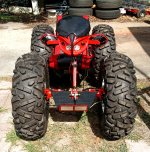Bgt2u
1 W
- Joined
- May 31, 2020
- Messages
- 58
I am thinking of lowering my voltage from 60v to 48v. The reason is I am looking for more miles between charges, with the same amount of torque. My controller and motor can run
from 48v to 72v. If l changed the battery from 60v 60ah, to 48v 60ah, would l have the same acceleration as the 60v setup?
from 48v to 72v. If l changed the battery from 60v 60ah, to 48v 60ah, would l have the same acceleration as the 60v setup?
Last edited:









